West End Common forms part of the Esher Commons It was designated a Site of Special Scientific Interest (SSSI) in 1995 for its wide variety of habitats and associated species. In this bulletin we cover some of the work volunteers have undertaken over the past year around West End Common to help in the preservation of this wonderful site and its rich biodiversity.
Blackthorn is one of the first blossoms to display in the spring with its clouds of white flowers along the hedgerows. It’s a native plant and the vicious thorns make it an excellent plant for stockproof hedging along with Hawthorn. Its berries are also useful for making sloe gin! It is a hugely valuable wildlife habitat throughout all the seasons for a wide array of wildlife. The early flowers provide an important source of nectar and pollen for the first bees of the spring and its foliage is a food plant for the caterpillars of many species of moth. The rare brown hairstreak butterfly found here on the Esher Commons relies on young blackthorn growth to lay its eggs. It prefers 2-5 year old shoots that are clear of lichens and algae.
The dense, thorny growth of blackthorn also provides ideal nesting habitat for skulking birds like blackcap, chiffchaff, whitethroat, and nightingale. The berries (sloes) also provide food for birds and mammals in Autumn, and the dense growth provides well insulated shelter for roosting birds in the coldest months.
Blackthorn requires the right management to retain the various conditions and attributes it has for all this different wildlife. If left unmanaged, it becomes rangy and overstood with too much empty space at the base, instead of lush and bushy throughout. To keep it growing thick and full, it is coppiced. Coppicing is the cutting of tree stems at the base, to stimulate vigorous, multi-stemmed regrowth. This new regrowth is essential for brown hairstreak butterflies to lay their eggs on, and the resulting dense growth is needed for those many species of bird.
As with many types of habitat management, this process is done on a cycle or rotation, in order to create and maintain a mosaic; a varied environment of different growth heights, stages and levels of succession, as well as different interfaces and edges in the habitat. The area of scrub is loosely divided into several ‘plots’, which are each done in consecutive winters, so there is a continuous cycle of this diversity. So one year, one plot is cut, then the next plot is cut the following year, and so on, until after a few years each plot has been cut and the cycle begins again. This process also has a dramatic and dynamic effect on the ground flora. Because at every stage of this cycle there are areas of ground entirely opened up to the light, there is always space for ground flora to exploit and flourish, further adding to the variety of life, providing a haven of food sources for nectaring insects.
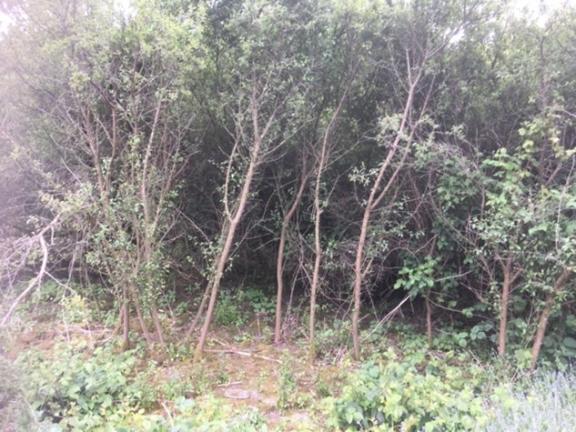
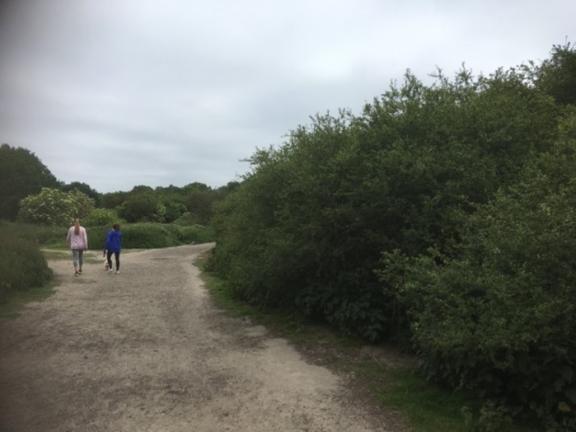
In 2021, the Elmbridge Countryside Volunteers spent two days coppicing a plot of blackthorn by West End Lane car park, and two days last winter cutting the next plot along. It was tough work, but the results are worth it.
You can see from the recent photos below a wonderful range of wildflowers have sprung to life including cut-leaved cranesbill, white deadnettle, thistles, green alkanet, scarlet pimpernel, forget-me-nots and even a pyramidal orchid!
Over the next few years, we will cut each plot in turn to maintain a variety of stages of development, for the associated wildlife.
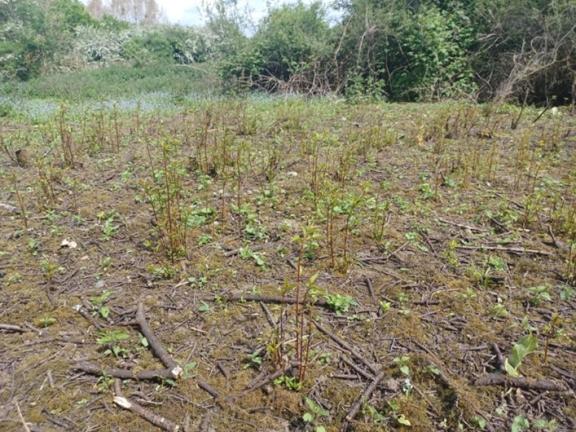
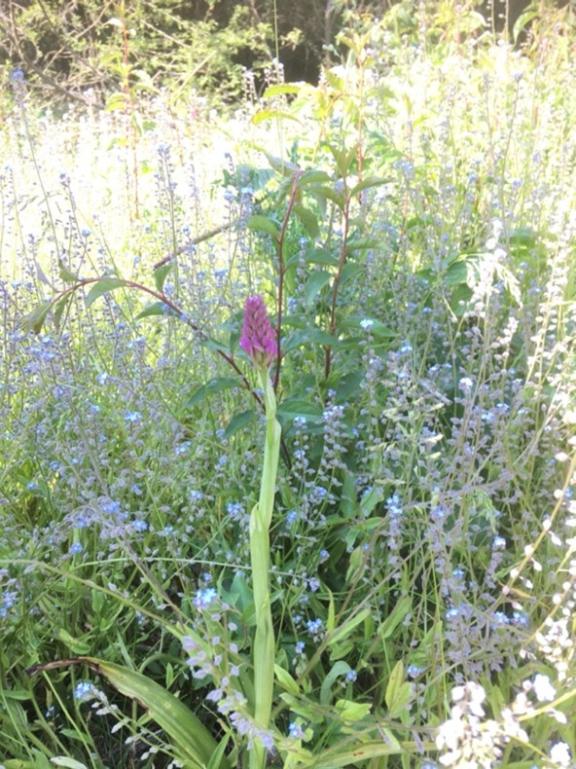
A less welcome plant on West End Common, especially copious at the Ledges, is Rhododendron ponticum. People may think it’s a pretty shrub but there is another side to the story.
It was first introduced in the 1700s and subsequently the Victorians planted it for its ornamental value and as cover for game birds. It is extremely invasive, spreading by seed and a rampant root system. In addition, the foliage is poisonous to livestock and toxins are thought to be released which inhibits the growth of other plants. If left to its own devices, it will quickly dominate the woodland floor at the expense of other plants, strangling native tree saplings and cloaking the ground in darkness, inhibiting the growth of wildflowers. This is particularly relevant to the Ledges which is an ancient woodland with many rare species.
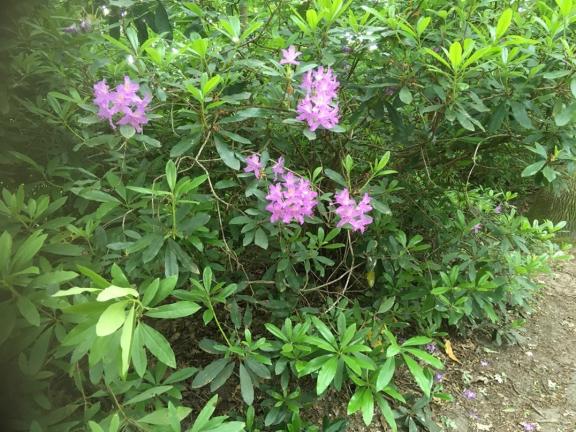
Groups of volunteers have spent several days over the last year cutting down the Rhododendron around West End Common which has let light into the woodland floor but there is much more work to do to rid the common of this troublesome plant.
On a brighter note, the common is host to several ponds which when in good health provide a habitat for a very wide variety of wildlife. Sadly, many of the ponds had recently become infested with the highly invasive non-native aquatic plant New Zealand pygmyweed (Crassula Helmsii). As a result, the water area was considerably reduced, and light could not reach the water, shading out the variety of native aquatic plants and negatively impacting the associated invertebrate assemblage.
The Elmbridge Borough Council ranger team carried out extensive mechanical removal of the New Zealand pygmyweed during the autumn. The huge mats of the plant are banked up away from the water so not to re-establish, but still left close enough that any tiny invertebrates inadvertently pulled out during the work can crawl and fly back into the ponds with ease.

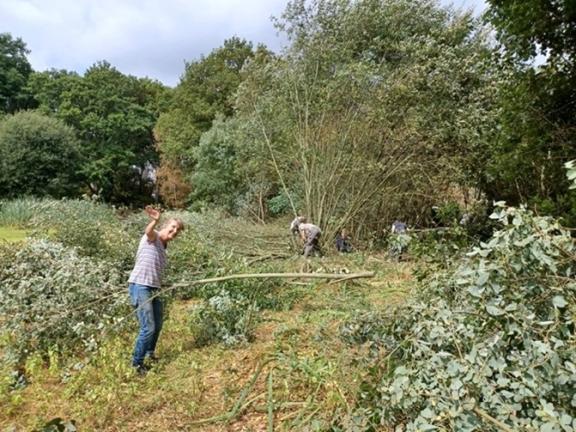
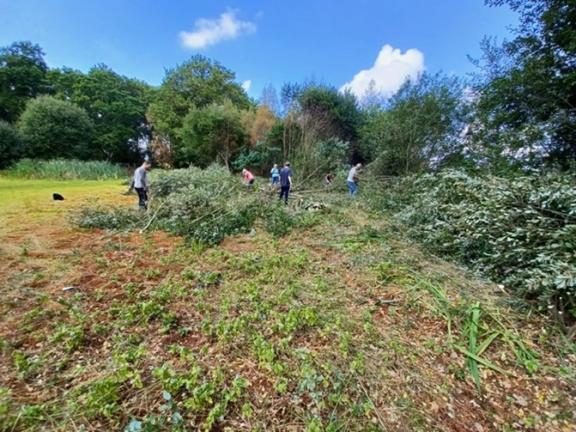
Before the ranger team commenced the crassula removal, we spent a day coppicing the willow at Halfpenny Pond and building dead hedges with the arisings around the perimeter. As with the blackthorn, coppicing the willow stimulates vigorous thick multi-stemmed regrowth for birds to nest in, and maintains a variety of stages of succession and habitat mosaic. The dead hedges have a dual purpose. They provide cover for wildlife such as hibernating amphibians, as well as nesting habitat for small birds and small mammals. They also deter dogs from disturbing the delicate aquatic wildlife. Many thanks to those of you who don’t let their dogs romp around in the ponds!
As you can see, the result from the crassula removal last autumn is a far more open pond with ample open water providing more opportunities for wildlife to thrive. The result of the coppicing is a mixture of sizes and structures in the willows, including brand new lush regrowth that insects will feed upon and take refuge in.
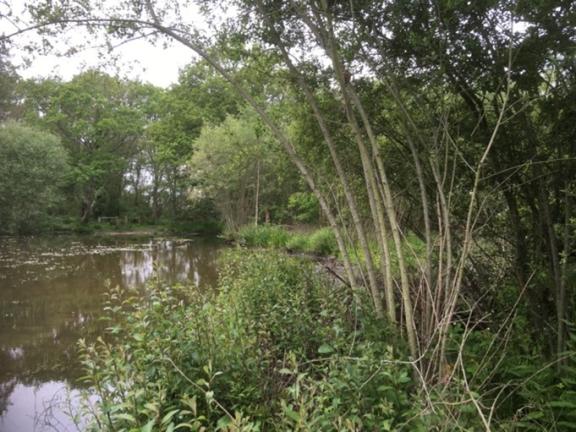
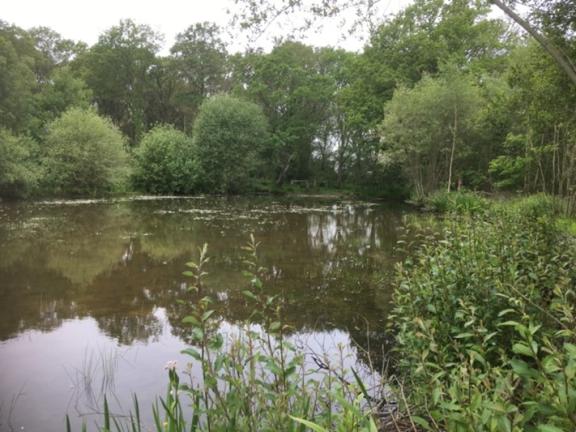
And finally, Himalayan Balsam is another 19th century import which has become highly invasive. It has a pretty slipper shaped pink flower but when its seed pod explodes the seeds are cast up to 7 meters away. As you can imagine with each plant producing around 2,500 seeds, it spreads like wildfire!
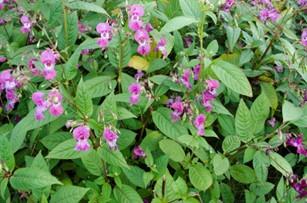
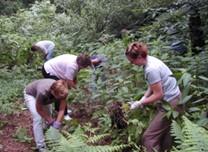
As with other invasive species if left to its own devices it will dominate the native wildflowers and eventually outcompete them. Understandably the best time to tackle it is before it flowers so you will see groups of volunteers in May and June “Balsam pulling”.
Fortunately, it is easy to pull up by the roots so if you see any please feel free to pull it up!
There is enormous potential to improve this wonderful and diverse countryside site, but it will require more work by volunteers so please come and join us!
We look forward to seeing you in the woods soon!
For more information on getting involved, see volunteering.